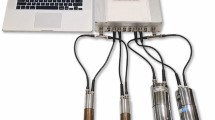Conclusions
Theoretical calculations are given of the distribution of particle sizes and weight proportions of individual fractions necessary for the attainment of maximum density in tubular, annular, and “inversed” fuel elements as a result of vibratory densification. It is shown that, in the attainment of a high and uniform packing density, of vital importance are the ratios between the dimensions of the shell of the vessel and the diameter of the coarse-fraction particles, and also of the particle sizes of the remaining fractions. The particles of these fractions must fit the residual interstitial voids, whose distribution is not uniform even in tubular fuel elements. Measurements, made with a gamma-ray meter, have demonstrated that there is good agreement between actual and calculated axial density distributions. It seems reasonable to assume that the procedure described should make it possible to obtain, in some cases at any rate, the relatively uniform packing density that is required in the compaction of metal powder parts of complex configuration.
Similar content being viewed by others
Literature cited
H. H. Hausner (editor), Perspectives in Powder Metallurgy, Vol. 2, Vibratory Compacting: Principles and Methods, Plenum Press, New York (1967).
J. Vogt and B. Zivanovic, IBK-AB Atomenergi Rept., Vinca (1967).
J. Vogt, B. Zivanovic, P. Anastasijevic, V. Mikijelj, and M. M. Ristic, Proceedings of an International Atomic Energy Agency Conference on Heavy Water Power Reactors, Paper SM-99/66, Vienna (1967).
V. in der Schmitten, Rept. KR-89 (1965).
J. J. Hauth, Rept. HW-67777 (1961).
B. Zivanovic, M. Zivkovic, and M. Memedovic, Rept. IBK-704 (1968).
R. K. McGeary, J. Am. Ceram. Soc.,44, No. 10, 513 (1961).
P. van Asbroeck and W. Wieczorkowsky, Rev. Met.,66, 63 (1969).
P. Papeleux and A. J. Flipot, J. Nucl. Mater.,36, 275 (1970).
Proceedings of an International Atomic Energy Agency Round Table Meeting on Sol-Gel Processes and Their Applications, Vienna (1968).
T. Bariout, private communication.
J. Vogt and B. Zivanovic, Bull. Boris Kidrich Inst.,19, Ceram. Met., 2, 15 (1968).
R. G. Waymer, U. S. Atomic Energy Commission Publ. ORNL-TM-2205 (1968).
Author information
Authors and Affiliations
Additional information
Translated from Poroshkovaya Metallurgiya, No. 5 (113), pp. 93–99, May, 1972.
Rights and permissions
About this article
Cite this article
Živanović, B., Mikijelj, V. Vibratory densification of dispersion-type fuel elements for nuclear reactors. Powder Metall Met Ceram 11, 414–418 (1972). https://doi.org/10.1007/BF00797750
Received:
Issue Date:
DOI: https://doi.org/10.1007/BF00797750



